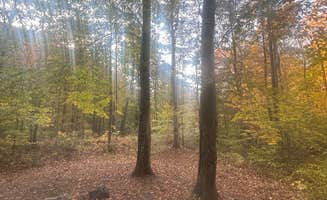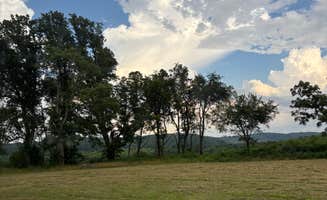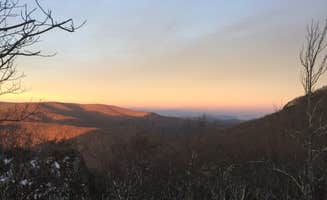Dispersed camping options near Altavista, Virginia center primarily on George Washington National Forest, where rustic camping opportunities can be found within 45-60 minutes' drive. The forested mountainous terrain ranges from 1,000-3,000 feet elevation, creating diverse camping environments. Winter temperatures frequently drop below freezing at higher elevations, while summer brings dense vegetation and increased insect activity.
What to do
Hiking from camp: The Spy Rock area connects directly to the Appalachian Trail, offering immediate access to hiking without moving your vehicle. "This is one of my favorite hikes in the Shenandoah Valley... Flat, open, space for a fire. What more could you ask for?" notes a Spy Rock camper.
Creek exploration: Most Forest Road 812 sites feature access to small creeks suitable for filtering water and cooling off. "Nice camping spots on the pedlar river in Amherst county. Multiple spots along Reservoir Road," reports one visitor who enjoyed water access.
Solitude seeking: For those wanting complete isolation, James River WMA offers fields where you rarely encounter others. A camper observed, "I never saw another person camping... I was the only one here all day" at this permit-required area.
What campers like
Stone fire features: Many Forest Road 812 sites contain well-established fire rings. "There was a fire ring and man made stone oven at the site we chose," notes one camper at Dispersed Camping Site off FR 812, highlighting unique cooking options.
Multiple site options: When sites fill up, continuing down forest roads typically reveals alternatives. "We came for this site specifically but it was already occupied so we kept going down the road. Luckily there were 4-5 additional site & we got one for 3 nights," explains a George Washington National Forest off 812 visitor.
Morning atmosphere: Early risers appreciate the peaceful settings. One camper at Johns Spring Shelter on the Appalachian Trail shared, "It's a decent spot to stay the night especially if it's not crowded! There's a few other shelters and stealth sites in the area that are also great options."
What you should know
Water planning essential: Reliable water sources are inconsistent. At Johns Spring Shelter, "There is not a water source too close to the shelter. The closest one is about 3 miles North," warns one hiker.
Site competition: During peak times (spring/fall weekends), arrive early. "Showed up around 5pm and were the only ones there," notes one lucky camper, while another mentions, "Multiple road sites that fit my van with room to spare - 80% were full on a beautiful fall Friday evening."
Access considerations: Road conditions vary significantly with weather. "It is a very rocky path, about 50 feet long, to get into the campground, but then it is smooth and well laid out," explains one reviewer about Forest Road sites.
Tips for camping with families
Group-friendly spots: Some areas accommodate multiple tents and vehicles. "There is a giant fire circle in the middle and enough room to fit about 10 vehicles/groups if people don't mind being next to each other," notes a camper at a James River Wildlife Management Area.
Flat terrain options: For easier tent setup with children, seek out designated sites. "The spot was nice and flat, backed up to a little creek and had an established stone fire ring," mentions a parent who camped with family.
Nearby attractions: Natural Bridge provides a kid-friendly day trip. "This is a very nice woodsy campsite close to Natural Bridge!" suggests a family that used their campsite as a base for exploration.
Tips from RVers
Size limitations: Most dispersed sites accommodate smaller RVs only. "I opted to park it in a field/parking area at the entrance. I was the only one here all day," explains an RVer with a 29-foot Class C at the James River WMA.
Field camping: The most reliable larger vehicle parking is at wildlife management areas rather than forest roads. "It almost immediately opens up into an open field where large rigs of any size can fit," advises a long-term RVer.
Connectivity concerns: Cell service is spotty and carrier-dependent. "I had great T-Mobile service, but no ATT service—even with a powerful LTE antenna," reports one camper who needed to stay connected for work.






